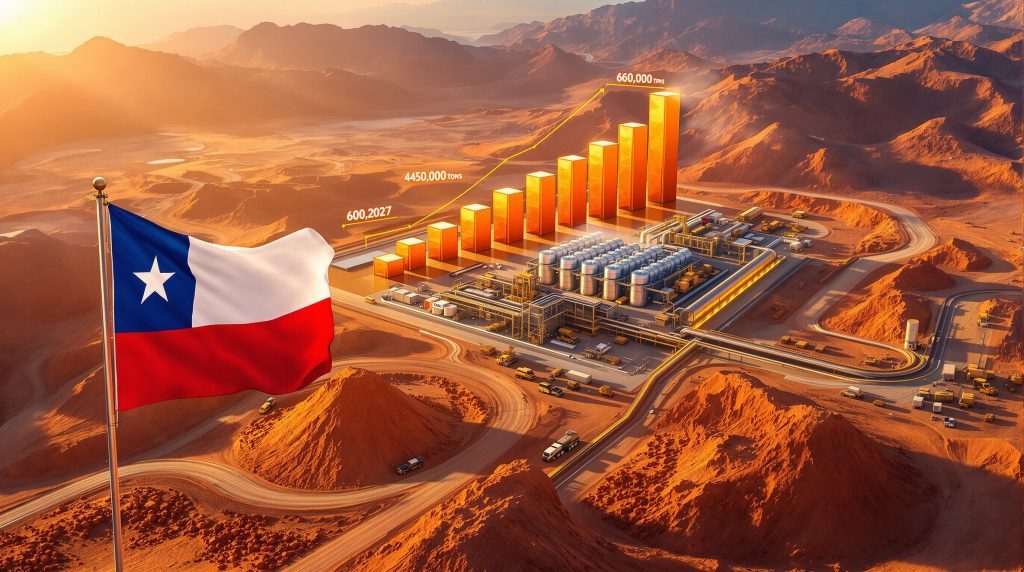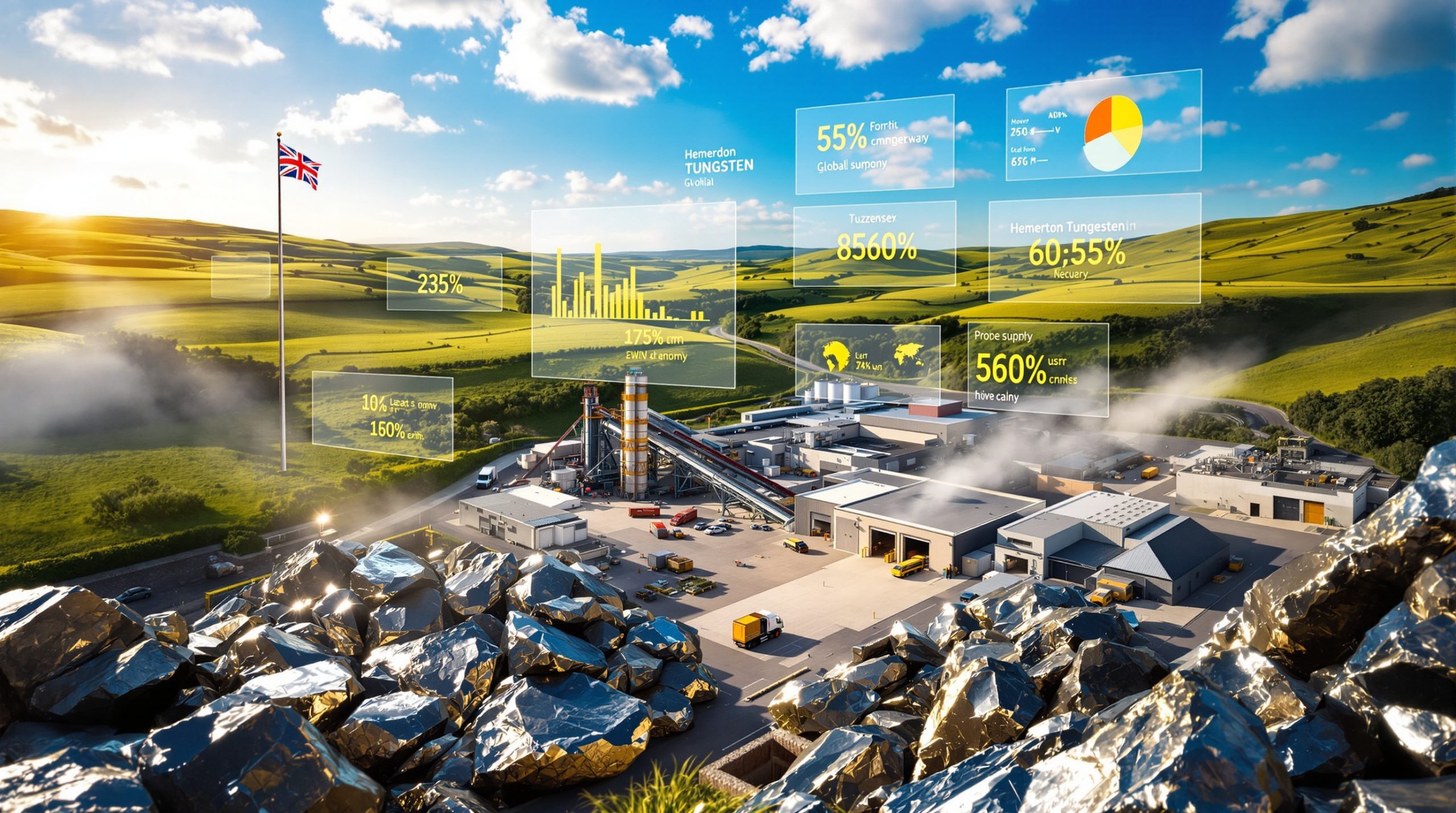What Makes Collahuasi a Critical Player in Global Copper Supply?
Chile's position as the world's leading copper producer stems from its exceptional geological endowments and decades of mining expertise. The nation accounts for approximately 28% of global copper production, making it an indispensable component of international supply chains. Within this landscape, certain operations stand out as particularly influential in shaping market dynamics, especially when considering recent copper price predictions and their impact on global supply.
Understanding Chile's Copper Mining Landscape
The Chilean copper sector operates within a framework of both state-owned enterprises and private ventures, creating a diverse operational environment. Codelco, the state-owned mining giant, maintains its position as the world's largest copper producer by volume, while private operators contribute significantly to national output through advanced technological implementations and strategic partnerships.
Chile's mining regions benefit from unique geological formations created by volcanic activity over millions of years. The Atacama Desert region, in particular, hosts some of the world's most significant copper deposits, characterised by porphyry systems that contain substantial ore bodies suitable for large-scale extraction.
Collahuasi's Position Among World's Largest Copper Operations
Operating in Chile's northern Tarapacá region, Collahuasi represents one of the top 10 copper mines globally by production capacity. At full operational levels, the mine produces approximately 600,000 metric tons annually, positioning it alongside other major operations such as Escondida and Los Pelambres in terms of strategic importance.
The mine's significance extends beyond mere production volumes. Its high-grade ore deposits and established infrastructure make it a cornerstone asset for meeting growing global copper demand. Industry projections indicate that global copper consumption will increase by 2.5% to 3% annually over the next two decades, driven primarily by renewable energy infrastructure and technological advancement requirements, particularly as experts analyse the copper demand surge across multiple sectors.
Joint Venture Structure and Ownership Dynamics
Collahuasi operates under a partnership structure that brings together major international mining corporations. Anglo American and Glencore each maintain 44% ownership stakes, while a Mitsui-led consortium holds the remaining 12%. This arrangement combines Anglo American's operational expertise with Glencore's trading capabilities and Mitsui's regional market knowledge.
The joint venture model provides several strategic advantages:
• Risk distribution across multiple stakeholders
• Capital investment sharing for major infrastructure projects
• Technical expertise pooling from diverse operational backgrounds
• Market access through established global networks
This ownership structure has proven particularly valuable during challenging operational periods, allowing partners to leverage their combined resources for infrastructure improvements and technological upgrades.
Why Has Collahuasi's Production Been Below Expectations?
Recent production challenges at Collahuasi reflect broader industry trends affecting copper mining operations worldwide. Multiple factors have contributed to output levels falling short of the mine's 600,000 metric ton annual capacity, creating ripple effects throughout global copper markets, particularly when considering current global copper supply forecast projections.
Ore Grade Challenges in Current Mining Areas
Mining operations naturally progress through different zones within ore bodies, encountering varying mineral concentrations as extraction advances. Collahuasi currently operates in areas where copper grades are lower than optimal, requiring increased processing volumes to achieve equivalent metal output.
Lower-grade ore zones present several operational challenges:
• Increased processing costs per unit of copper produced
• Higher energy consumption for grinding and flotation processes
• Extended processing times affecting overall throughput
• Reduced plant efficiency due to handling larger ore volumes
These factors collectively impact the mine's ability to maintain consistent production levels, resulting in annual output closer to 450,000 tons rather than the targeted capacity.
Water Supply Constraints Affecting Operations
Water availability represents a critical constraint for copper mining operations in Chile's arid northern regions. Collahuasi's operations require substantial water volumes for ore processing, dust suppression, and equipment cooling, making reliable water access essential for maintaining production levels.
The mine's current water supply system faces several limitations:
• Seasonal availability variations affecting consistent supply
• Regulatory restrictions on groundwater extraction
• Competition with local communities and other industrial users
• Transportation costs for water delivery from distant sources
These constraints have periodically forced production adjustments, contributing to output variability and operational inefficiencies.
Processing Plant Efficiency Issues
Copper processing facilities require precise operational parameters to maximise metal recovery rates. Plant efficiency challenges at Collahuasi have included equipment maintenance requirements, process optimisation needs, and adaptation to varying ore characteristics.
Key operational factors affecting plant performance include:
• Equipment wear from processing harder ore materials
• Flotation circuit optimisation for different mineral compositions
• Energy system reliability for consistent processing power
• Maintenance scheduling to minimise production disruptions
Lower-grade ore zones have reduced annual output from the targeted 600,000 metric tons, creating supply chain ripple effects across global copper markets.
How Will the New Desalination Plant Transform Operations?
Water security represents one of the most significant operational improvements planned for Collahuasi's future production capabilities. The new desalination plant under construction promises to eliminate water supply constraints that have historically limited production flexibility.
Water Security Solutions for Mining Operations
Desalination technology offers copper mining operations in arid regions a sustainable water supply solution independent of local freshwater resources. For Collahuasi, this infrastructure investment addresses both immediate operational needs and long-term production planning requirements.
The desalination plant will provide several operational advantages:
• Consistent water supply regardless of seasonal variations
• Reduced dependency on competing water sources
• Operational flexibility for production planning
• Environmental compliance with reduced groundwater usage
Modern desalination facilities utilise reverse osmosis technology to produce high-quality water suitable for mining operations while minimising energy consumption compared to earlier desalination methods.
Timeline for Full Plant Integration
Construction and commissioning of the desalination plant follows a phased implementation schedule designed to minimise operational disruptions while maximising production benefits. The facility is expected to reach full operational capacity by the second half of 2026.
Implementation phases include:
• Construction completion by early 2026
• System testing and commissioning during first half 2026
• Gradual capacity ramp-up through second half 2026
• Full integration with existing processing systems by 2027
Production Capacity Improvements Expected
Water availability improvements from the desalination plant directly support production capacity restoration to full design levels. This infrastructure enhancement removes a key constraint that has limited operational flexibility in recent years, positioning the operation for the Anglo American Chile copper mine full output 2027 target.
| Infrastructure Component | Current Status | 2027 Target |
|---|---|---|
| Desalination Plant | Under Construction | Fully Operational |
| Water Supply Capacity | Limited | Unrestricted |
| Annual Production | ~450,000 tons | 600,000 tons |
What Role Does Higher-Grade Ore Play in the 2027 Recovery?
Geological progression through different ore zones represents a natural evolution in large-scale mining operations. Collahuasi's planned transition to higher-grade areas coincides with infrastructure improvements to create optimal conditions for production recovery.
Geological Transition to Richer Mining Areas
Open-pit mining operations advance through systematically planned sequences based on geological surveys and resource modelling. Collahuasi's mining plan incorporates transitioning to higher-grade ore zones in the latter half of the operational timeline.
Geological characteristics of upcoming mining areas include:
• Enhanced copper concentrations compared to current zones
• Improved mineral recovery potential during processing
• Reduced waste rock ratios for more efficient extraction
• Optimised ore body access through established infrastructure
Expected Copper Content Improvements
Higher-grade ore zones typically contain increased copper percentages per ton of material processed, directly improving operational efficiency and production economics. These improvements reduce processing costs while increasing metal output from equivalent ore volumes.
Expected improvements include:
• Higher copper grades in processed ore
• Improved recovery rates during flotation processes
• Reduced processing requirements per unit of copper produced
• Enhanced operational margins through improved efficiency
Processing Efficiency Gains
Higher-grade ore materials require less intensive processing to achieve equivalent copper recovery, improving overall plant efficiency and reducing operational costs. These efficiency gains support sustained production at design capacity levels.
Processing improvements include:
• Reduced grinding requirements for ore preparation
• Shorter flotation residence times for metal recovery
• Lower reagent consumption per ton of copper produced
• Increased throughput capacity through improved efficiency
How Does the Proposed Anglo-Teck Merger Impact Collahuasi's Future?
The proposed merger between Anglo American and Teck Resources creates significant strategic opportunities for Collahuasi's operational integration with neighbouring mining assets. This combination could establish one of the world's largest copper production complexes.
Strategic Integration with Quebrada Blanca Operations
Quebrada Blanca, operated by Teck Resources, sits in close proximity to Collahuasi, creating opportunities for operational synergies and shared infrastructure utilisation. The integration potential between these operations represents a key strategic value driver for the proposed merger.
Integration opportunities include:
• Shared processing facilities for ore from both operations
• Combined logistics systems for material transportation
• Integrated power infrastructure for reduced operational costs
• Unified water management systems across both sites
Potential 175,000 Ton Annual Production Boost
Technical analysis indicates that Collahuasi's high-grade ore could be processed through Quebrada Blanca's facilities, potentially adding 175,000 tons of annual copper production to the combined operation's output, according to recent industry reports highlighting Anglo sees Chile copper mine returning to full output in 2027.
This production enhancement would result from:
• Optimised ore blending between the two operations
• Improved processing efficiency through facility integration
• Increased utilisation rates of existing infrastructure
• Enhanced metal recovery through process optimisation
$1.4 Billion Profitability Enhancement Projections
Financial modelling suggests the integration could generate approximately $1.4 billion in annual profitability improvements through operational synergies and enhanced production capabilities.
Profitability improvements would stem from:
• Reduced operational costs through shared infrastructure
• Increased production volumes from integrated operations
• Improved processing efficiency across combined facilities
• Enhanced logistics optimisation for material handling
The merger could create synergies between neighbouring operations, optimising ore processing and reducing operational costs across the combined portfolio.
What Are the Broader Market Implications of Collahuasi's Recovery?
Collahuasi's production recovery occurs within a global copper market characterised by supply constraints and increasing demand from multiple sectors. The mine's return to full capacity represents a significant supply addition during a period of market tightness.
Global Copper Supply Tightness Factors
International copper markets face supply challenges from multiple sources, making reliable production from established operations increasingly valuable for market stability. However, external factors such as tariff impact on copper continue to influence market dynamics.
Supply constraint factors include:
• Project development delays affecting new mine commissioning
• Operational disruptions at existing major producers
• Regulatory challenges impacting expansion projects
• Geopolitical tensions affecting international trade flows
Energy Transition Demand Drivers
The global energy transition toward renewable sources creates substantial copper demand for electrical infrastructure, energy storage systems, and electric vehicle production. This demand growth supports long-term price stability for copper producers.
Energy transition applications include:
• Wind turbine construction requiring substantial copper content
• Solar panel infrastructure and associated electrical systems
• Electric vehicle production for motors and charging infrastructure
• Grid modernisation for renewable energy integration
Data Centre and AI Infrastructure Requirements
Artificial intelligence development and expanded data centre capacity create additional copper demand for electrical systems, cooling infrastructure, and power distribution networks.
Technology sector demand includes:
• Server infrastructure requiring copper-intensive electrical systems
• Cooling system installations for heat management
• Power distribution networks for high-capacity operations
• Telecommunications infrastructure supporting data transmission
Which Challenges Could Affect the 2027 Timeline?
Despite optimistic projections for production recovery, several potential challenges could impact the proposed timeline for achieving Anglo American Chile copper mine full output 2027 objectives.
Regulatory Approval Dependencies
Both infrastructure development and operational changes require regulatory approval from Chilean authorities, creating potential timeline risks if approval processes experience delays.
Regulatory requirements include:
• Environmental impact assessments for infrastructure projects
• Water usage permits for desalination plant operations
• Mining plan approvals for ore zone transitions
• Safety compliance certifications for operational changes
Partner Negotiation Complexities
The joint venture structure requires coordination among multiple stakeholders, potentially creating challenges if partners have differing priorities or timeline expectations.
Partnership considerations include:
• Investment approval processes across multiple organisations
• Strategic alignment on operational priorities
• Resource allocation decisions for infrastructure projects
• Integration planning with potential Anglo-Teck merger implications
Technical Implementation Risks
Complex technical projects inherently carry execution risks that could affect timeline achievement or performance expectations.
Technical risk factors include:
• Equipment commissioning challenges for new infrastructure
• Process optimisation requirements for efficiency improvements
• System integration complexities between old and new facilities
• Operational learning curves for new processes and equipment
What timeline challenges could affect production recovery?
Regulatory approvals, partner coordination, and technical implementation risks represent the primary factors that could potentially delay the Anglo American Chile copper mine full output 2027 timeline.
Why is water infrastructure critical for mining operations?
Desert mining operations require substantial water volumes for processing, making desalination plants essential for consistent production levels in Chile's arid regions.
How does ore grade transition impact production capacity?
Higher-grade ore zones require less processing per unit of copper produced, improving efficiency and enabling full capacity utilisation when combined with adequate infrastructure.
Investment Implications for Global Copper Markets
Collahuasi's production recovery timeline carries significant implications for copper market dynamics and investment strategies focused on the base metals sector. Furthermore, investors exploring copper investment strategies should consider these developments carefully.
Supply Security Considerations
Reliable copper supply from established operations becomes increasingly valuable as global demand continues expanding. Collahuasi's production recovery provides market participants with improved supply security during a period of constrained new project development.
Supply security factors include:
• Established infrastructure reducing development risks
• Proven ore reserves supporting long-term production planning
• Experienced operational teams minimising execution risks
• Strategic partnerships providing operational stability
Price Impact Projections
Additional copper supply from Collahuasi's recovery could moderate price pressures in global markets, though the impact depends on simultaneous demand growth from energy transition and technology sectors.
Price consideration factors include:
• Supply timing relative to demand growth rates
• Market inventory levels affecting price sensitivity
• Competing supply sources and their production reliability
• Macroeconomic conditions influencing demand patterns
Long-term Demand Growth Patterns
Sustained demand growth from electrification trends and infrastructure modernisation supports positive long-term market fundamentals for copper producers.
Demand growth drivers include:
• Electric vehicle adoption requiring substantial copper content
• Renewable energy infrastructure development globally
• Grid modernisation projects in developed and developing markets
• Industrial automation and technology advancement requirements
With new copper projects requiring 15-20 years for development, existing large-scale operations like Collahuasi become increasingly valuable for meeting projected 2.5-3% annual demand growth.
Disclaimer: This analysis contains forward-looking statements and projections that involve inherent risks and uncertainties. Actual mining production, market conditions, and corporate developments may differ materially from those discussed. Investment decisions should not be based solely on this information and should consider professional financial advice and comprehensive market research.
Further Exploration:
Readers interested in learning more about major copper mining developments can explore additional industry analysis through resources such as Bloomberg's coverage of Anglo's 2026 output warnings and related educational content on global copper supply dynamics.
Looking to Capitalise on Major Copper Developments?
Discovery Alert's proprietary Discovery IQ model delivers instant notifications when significant copper and mining discoveries are announced on the ASX, helping subscribers identify actionable trading opportunities ahead of broader market movements. Explore Discovery Alert's dedicated discoveries page to understand how historic mineral discoveries have generated substantial returns, then begin your 30-day free trial to position yourself for the next major breakthrough.




